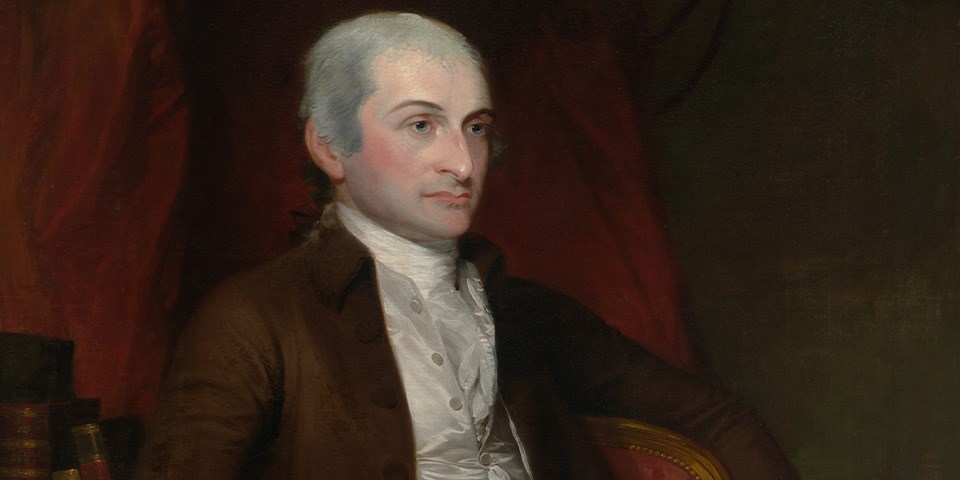Part of a series of articles titled The Constitutional Convention: A Day by Day Account for July 16 to 31, 1787.
Article
July 25, 1787: Stuck

National Portrait Gallery, Smithsonian Institution, https://npg.si.edu/object/npg_NPG.74.46?destination=edan-search/default_search%3Fedan_local%3D1%26edan_q%3Djohn%252Bjay
"Permit me to hint, whether it would not be wise and seasonable to provide a strong check to the admisson of Foreigners into the administration of our national Government."
--John Jay to George Washington
The previous day’s controversy was revisited regarding how the President would be chosen and how to balance the President’s power.
Ellsworth (CT) motioned for the national legislature to choose the President except when the President was running for reelection, in which case electors chosen by the state legislatures would decide. The purpose was to keep a President running for reelection from being beholden to the national legislature.
Gerry (MA) repeated what he had had said many times before: “an election at all by the National Legislature was radically and incurably wrong.” He moved for the national executive to be chosen by the states’ executives, with larger states having a proportionally larger vote.
Madison (VA) gave a long speech analyzing the pros and cons of every proposed method for choosing the President. Surprisingly, he concluded that a national election was the least problematic option. Since a larger percentage of residents in the North could vote, a national election would weaken the political power of the South, which had a large enslaved population and stricter voting eligibility. Speaking as a Southerner, Madison was “willing to make the sacrifice.” He also thought this power imbalance would get better over time, since he anticipated rapid population growth in the South, as well as future “republican laws” passed by the Southern states which would give more people voting privileges.
Ellsworth’s proposal for the national legislature to elect the President failed, 4–7, with Pennsylvania, Connecticut, Maryland, and New Hampshire in support.
Charles Pinckney (SC) moved that the President be chosen by the national legislature, with a new twist: he would be reelectable, but not “for more than six years in any twelve years.”
Mason (VA) and Gerry liked this idea. It accorded the executive greater independence from the legislature, and it allowed for good Presidents to eventually be reelected.
Butler (SC) still wanted electors appointed by the state legislatures to choose the President. He thought each state should get an equal number of electors.
Gouverneur Morris (PA) stated that the best method would be a national election and the worst would be election by the national legislature. A compromise was Wilson’s (PA) from the previous day: having fifteen randomly chosen congressmen appoint the President.
Williamson (NC) noted that the greatest criticism of a national election was that people would vote for candidates from their own state, which would invariably make the winner of a national election the most popular candidate from the largest state. His proposed solution was to give all voters the chance to vote for three candidates, only one of whom could be from their home state.
G. Morris liked the idea, but thought each person should get to vote for two instead of three candidates. Madison was also enthusiastic.
Gerry remained steadfast that a popular election was a “radically vicious” idea. The people’s consciousness wasn’t nationally oriented, and designing elites would manipulate them into supporting the candidate of their choice.
Dickinson (DE) suggested each state pick a candidate by popular election and then the national legislature or a group of electors would choose from the slate of candidates who won the state elections.
C. Pinckney’s motion, limiting the President chosen by the national legislature to serving no “more than six years in twelve years,” failed, 5–6, with New Hampshire, Massachusetts, the Carolinas, and Georgia in favor.
Gerry and Butler (SC) moved for the five-member Committee of Detail to decide what to do with the tangled knot of questions related to the Presidency, an idea Langdon (NH) liked, but that Wilson deplored, since the issue was too important to cast aside that easily.
The Convention adjourned.
- John Jay wrote to Washington (VA) to assure him that he had delivered Washington’s letters to John Paul Jones.
- As President of Pennsylvania, Franklin presided over the Supreme Executive Council.
- Randolph (VA) wrote Colonel Daniel Shepherd of Kentucky (then a western territory of Virginia), explaining that he couldn’t divulge the Convention’s secret proceedings but that “our western friends, beyond the Allegheny, may be assured that we shall not be unmindful of their interests in our regulations.”
- After a clear, warm morning, an all-day rain set in.
Last updated: September 21, 2023
